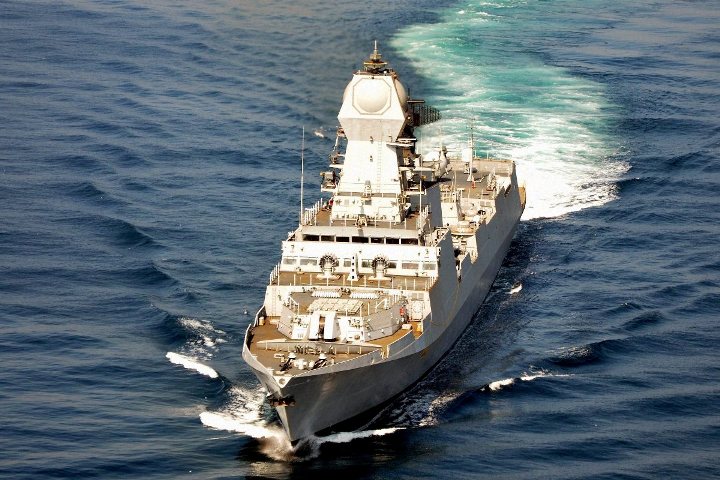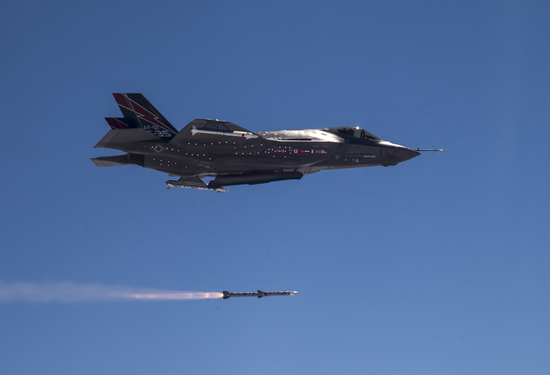
INS Kolkata -- India's largest indigenoulsy built warship.
By Ritu Mousumi Tripathy
As India has celebrated its 68th Independence Day, the induction of the first of three Project-15 (Alpha) "Kolkata" class multi-role destroyers in the Indian Navy on August 16 has marked a giant leap for the country in shipbuilding technology. Christened INS Kolkata, it is the biggest warship ever built in India and boasts of enhanced stealth features and land-attack capabilities over its predecessor -- the Delhi-class destroyers. Armed with modern sensors and weapons, including the BRAHMOS supersonic cruise missile system, it also has new look exteriors for improved stealth capability.
The commissioning of INS Kolkata symbolises another landmark achievement for India in successfully designing, developing and producing indigenous military platforms and systems for its armed forces.
Even after decades of restrictive technology denial regime imposed on it by the rich, powerful nations, India has successfully elevated its stature to a dignified level by acquiring critical military technology.
This is clearly evident from the fact that today India is listed as one among the few elite countries with the capability to build a nuclear submarine (Arihant), an aircraft carrier (Vikrant), a fourth-generation light combat aircraft (Tejas), an intercontinental ballistic missile (Agni), a submarine-launched ballistic missile (K-4/K-15), a supersonic cruise missile (BRAHMOS), a main battle tank (Arjun), a ballistic missile defence system and many other critical military systems and sub-systems including electronic warfare systems, radar systems, unmanned systems, laser technology and underwater sensors.
Even though faltered on several occasions with project delays, whopping costs, and technological shortcomings, (which are no exceptions and evident in many critical military projects undertaken even by leading military powers such as the US, Europe or Russia), indigenisation in Defence Technology has nevertheless steadily and surely witnessed the dawn in India.
With an all-round, comprehensive modernisation drive outlined for its armed forces, India targets to spend over $150 billion over the next five years on defence procurements, offering a lucrative market to the global military firms to grab a pie. This also offers a great opportunity for India's domestic defence sector to get a fair share of the huge money.
But the question here is: Is the Indian defence industry actually ready for its big share?
The provision in this year's Union Budget to raise the Foreign Direct Investment (FDI) limit in the Defence Sector from 26% to 49% surely paves the way and expands the scope for further increasing the indigenous content in the defence hardware which India plans to procure in the coming years.
Such a provision promises to woo the domestic private sector enterprises to come forth in a big way in not only partnering with global military firms, but also in establishing a strong manufacturing base in the country to produce state-of-the-art, high-end defence equipment. Many Indian private sector companies keen to make a foray into India's strategic sphere have already tied up with some of the leading international defence and aerospace firms to produce platforms and systems for the Indian armed forces.
Amidst all the euphoria, however, it would be pertinent to note that an increased investment in Defence Research undertaken by India would be equally essential to realise self-reliance in defence design and production. The dynamics of indigenisation would work well only when India also becomes a source of inventing and producing cutting-edge military technology of tomorrow rather than just relying on foreign firms to give access to their technology. Also important would be to nurture and retain the human resources talent pool within the country.
A welcome step in this direction is the Defence Research and Development Organisation's (DRDO) plans to set up R&D centres in universities and leading academic institutions located in different parts of the country to create a strong defence knowledge base. The knowledge base available in various academic institutions and industrial sector could be used for polarising the defence research and also for designing, testing, and developing defence and related items.
So far, India's defence research work has remained within the exclusive purview of DRDO even though the premier research agency has tied up with about 40 academic institutions, 15national Science and Technology agencies, 50 public sector undertakings and over 250 private sector enterprises to carry out R&D work.
Similarly, the Transfer of Technology (ToT) clause as highlighted by India's official Defence Procurement Procedure (DPP) needs to be leveraged on so as to gain maximum benefit while clinching any new arms procurement deal with a foreign country/firm.
To sum it up all, since its independence 67 years ago, India has charted a long, arduous path in giving a well-defined, dignified shape to its defence development and production sector. Starting almost from scratch and overcoming many challenges, today the country stands tall as one of the major Asian powers with an indigenous defence industry base.
In fact, with a right spirit and energy, India certainly holds the potential to catalyse and transform itself into a vibrant hub of world-class design, development, manufacturing and export hub of high-end defence products in the next two to three decades.
 Previous Article
Previous Article Next Article
Next Article











The Indian Air Force, in its flight trials evaluation report submitted before the Defence Ministry l..
view articleAn insight into the Medium Multi-Role Combat Aircraft competition...
view articleSky enthusiasts can now spot the International Space Station (ISS) commanded by Indian-American astr..
view article